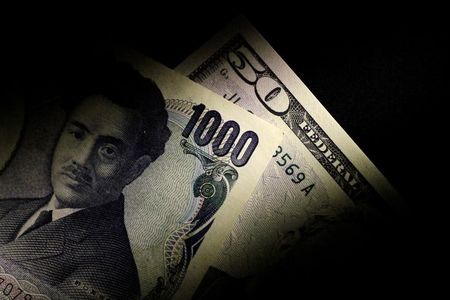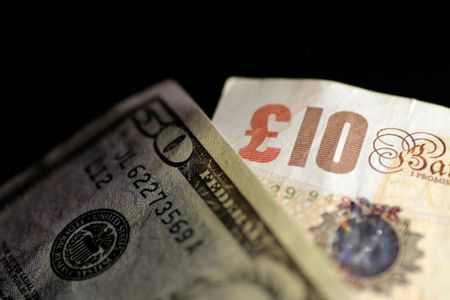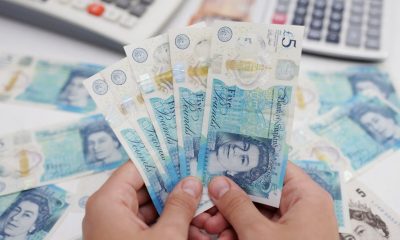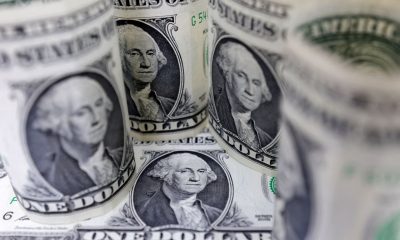Forex
Safe haven dollar edges higher after weak Chinese trade data

The U.S. dollar edged higher in early European trade Wednesday, as traders sought out this safe haven after disappointing Chinese trade data hit sentiment.
At 03:05 ET (07:05 GMT), the Dollar Index, which tracks the greenback against a basket of six other currencies, traded 0.1% higher at 104.162, not far removed from the 2½-month peak of 104.70 seen at the end of May.
China’s trade surplus sank to a 13-month low in May, according to data released earlier Wednesday, driven chiefly by a surprise drop in exports as foreign demand for Chinese goods dried up.
The slump in exports is indicative of slowing economic growth in Europe and the U.S., China’s primary markets for locally produced goods, and this has boosted demand for the dollar, a safe haven in times of stress.
The dollar has also benefited from the turmoil in the cryptocurrency markets, following the crackdown by the Securities and Exchange Commission on the crypto industry.
Gains are limited though as traders await next week’s Federal Reserve policy-setting meeting amid uncertainty of its next move.
Money markets are pricing in a roughly 19% chance that the U.S. central bank will raise rates by 25 basis points next week, compared to an over 60% chance a week ago, according to the CME FedWatch tool, after weak U.S. services activity data.
That said, the decision of the Reserve Bank of Australia to raise its cash target rate by 25 basis points on Tuesday, citing still high inflation, does create the possibility of an upside surprise.
It also puts the focus on the Bank of Canada’s meeting later this session amid speculation that it too could resume rate hikes, following recent sticky inflation data.
“A 25bp BoC rate hike … (now priced with a 43% probability) would probably cause ripples across core bond markets around the world and could keep the dollar bid on the view that the Fed might be closer to hiking than first thought,” said analysts at ING, in a note.
AUD/USD fell 0.1% to 0.6667, with the Aussie dollar handing back some of the previous session’s 0.8% gain, USD/CNY rose 0.1% to 7.1267, while USD/CAD rose 0.1% to 1.3420.
Elsewhere, EUR/USD fell 0.2% to 1.0676 after data showed that German industrial production rose slightly less than expected in April, increasing by 0.3% on the previous month, compared with the expected increase of 0.6%.
The European Central Bank also meets next week and is widely expected to continue hiking interest rates with inflation remaining well above the central bank’s 2.0% target.
The ECB hasn’t finished increasing borrowing costs as core inflation proves stubborn, Executive Board member Isabel Schnabel said in an interview with De Tijd.
“We have more ground to cover,” she was quoted as saying in the newspaper. “It will depend on the incoming data by how much more rates will have to increase.”
GBP/USD fell 0.2% to 1.2405 after data from mortgage lender Halifax indicated that British house prices dropped on an annual basis in May for the first time in 11 years.
Forex
More yen weakness likely – BOA Securities survey

Investing.com – More Japanese yen weakness looks likely, according to Bank of America Securities, citing its latest foreign exchange and rates sentiment survey.
At 10:25 ET (14:25 GMT), traded 0.2% higher at ¥155.83, with the pair having gained just under 2% this week as yen weakness returned.
Japanese authorities are seen having spent almost $60 billion the previous week pulling the yen away from a 34-year-low of ¥160.24 versus the dollar.
The bank’s survey has shown a consistently bullish yen bias since mid-2022, analysts at BOA Securities said, until now.
With USDJPY breaching new highs in April, investors have flipped to the largest JPY short since 2022, and there is a deep scepticism around the effectiveness of Japan’s FX intervention.
The bank said the majority of fund managers polled expect USDJPY to retest ¥160, with no one expecting a reversal to ¥150.
“While we generally share these views, the volte-face on JPY perhaps warrants near-term caution for shorts,” the bank added.
Forex
Dollar calm at end of week; sterling gains on growth data

Investing.com – The U.S. dollar steadied Friday after losing ground the previous session on weak jobs data, while the pound gained in the wake of stronger-than-expected growth numbers.
At 04:10 ET (08:10 GMT), the Dollar Index, which tracks the greenback against a basket of six other currencies, traded just higher at 105.115.
Dollar on track for small gains this week
The dollar steadied Friday, and is course for minor gains this week after losses on Thursday following the release of data showed a bigger-than-expected increase in weekly j.
This evidence of a cooling U.S. labor market reinforced some expectations that the will begin cutting interest rates by September.
However, sticky inflation remains a key point of contention for the Fed, with a slew of officials warning as much this week, comments which boosted the dollar this week.
There is “considerable” uncertainty about where U.S. inflation will head in coming months, San Francisco Federal Reserve President Mary Daly said on Thursday.
“In a scenario where inflation stays … level, just doesn’t make much further progress, then it’s not appropriate to start adjusting the rate unless we see the labor market faltering,” she added.
These comments put upcoming data, due next week, squarely in focus for more cues on interest rates.
Sterling benefits from strong growth data
In Europe, gained 0.1% to 1.2534, recovering from its lowest level since April 24 on Thursday, after data released earlier Friday showed that Britain’s economy grew by the most in nearly three years in the first quarter of 2024.
remove ads
.
U.K. expanded by 0.6% in the three months to March, the strongest growth since the fourth quarter of 2021, as the country’s economy exited the shallow recession it entered in the second half of last year.
On a monthly basis, the grew by 0.4% in March, faster than the 0.1% growth forecast.
The held interest rates at a 16-year high on Thursday, but two of the nine-person Monetary Policy Committee voted for a cut, suggesting that the central bank is moving towards such a reduction.
traded largely unchanged at 1.0783, with a light data calendar providing little impetus.
The has all but promised a rate cut on June 6, but uncertainty exists over how many further cuts the central bank will agree to this year.
Pierre Wunsch, Belgium’s central bank governor, made the case for further moves earlier this week, arguing that staying tight for too long was now a bigger risk than easing too early.
Markets currently price in 70 basis points of rate hikes for this year.
USD/JPY drifts higher
In Asia, rose 0.2% to 155.70, trading well above lows of 152 it had hit earlier in May.
Traders now see the 160 level as the new line in the sand for Japanese government intervention.
rose 0.1% to 7.2249, with the yuan weakening following reports saying U.S. President Joe Biden was considering imposing fresh sanctions on certain Chinese industries, such as electric vehicles and batteries.
remove ads
.
While the economic impact of the tariffs was unclear, such measures could attract retaliation from China, further souring ties between the world’s two biggest economies.
Forex
Asia FX weak with US inflation in sight; China tariff fears dent yuan

Investing.com– Most Asian currencies moved little on Friday as the dollar steadied from overnight declines, with focus turning squarely towards key U.S. inflation data due next week, which is likely to provide more cues on interest rates.
The Chinese yuan declined, as did currencies with trade exposure to China after multiple reports said that the U.S. was preparing more trade tariffs on Beijing.
Regional currencies took little support from an overnight decline in the dollar, as more signs of a cooling labor market reinforced bets that the Federal Reserve will cut rates in September.
But the dollar steadied in Asian trade, pressuring regional currencies as uncertainty ahead of key U.S. inflation data next week kept traders largely biased towards the greenback.
Chinese yuan weakens, USDCNY up on tariff reports
The Chinese yuan’s pair rose 0.1% as multiple reports said U.S. President Joe Biden was considering imposing fresh sanctions on certain Chinese industries, such as electric vehicles and batteries.
While the economic impact of the tariffs was unclear, such measures could attract retaliation from China, further souring ties between the world’s two biggest economies.
Other currencies with trade exposure to China fell tracking this notion. The Australian dollar’s pair fell 0.2%, while the Singapore dollar’s and the South Korean won’s pairs lost 0.1% and 0.3%, respectively.
Japanese yen remains fragile, USDJPY nears 156
Weakness in the Japanese yen persisted this week, as the pair recouped a bulk of its losses made after the government seemingly intervened in currency markets last week.
remove ads
.
The USDJPY pair rose 0.2% to 155.73 yen, trading well above lows of 152 it had hit earlier in May. Traders now saw 160 yen as the new line in the sand for Japanese government intervention.
Household spending data for March, released earlier on Friday, showed some resilience- a trend that could potentially underpin Japanese inflation expectations.
Dollar steadies, set for weekly gains ahead of inflation data
The and rose slightly in Asian trade, recovering a measure of overnight losses. But the greenback was still trading up about 0.2% for the week.
The greenback fell on Thursday after data showed a bigger-than-expected increase in weekly , furthering expectations of a cooling U.S. labor market.
This reinforced some expectations that the Fed will begin cutting interest rates by September.
But sticky inflation remained a key point of contention for the Fed, with a slew of officials warning as much this week.
Their comments put upcoming data, due next week, squarely in focus for more cues on interest rates.

 Forex2 years ago
Forex2 years agoForex Today: the dollar is gaining strength amid gloomy sentiment at the start of the Fed’s week

 Forex2 years ago
Forex2 years agoHow is the Australian dollar doing today?

 Forex1 year ago
Forex1 year agoUnbiased review of Pocket Option broker

 Forex2 years ago
Forex2 years agoDollar to pound sterling exchange rate today: Pound plummeted to its lowest since 1985

 Cryptocurrency2 years ago
Cryptocurrency2 years agoWhat happened in the crypto market – current events today

 World2 years ago
World2 years agoWhy are modern video games an art form?

 Stock Markets2 years ago
Stock Markets2 years agoMorgan Stanley: bear market rally to continue

 Economy2 years ago
Economy2 years agoCrude oil tankers double in price due to EU anti-Russian sanctions





























